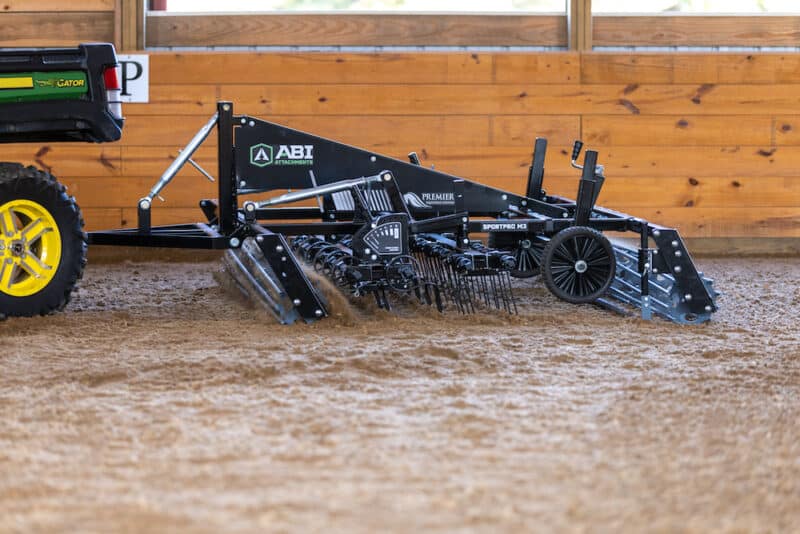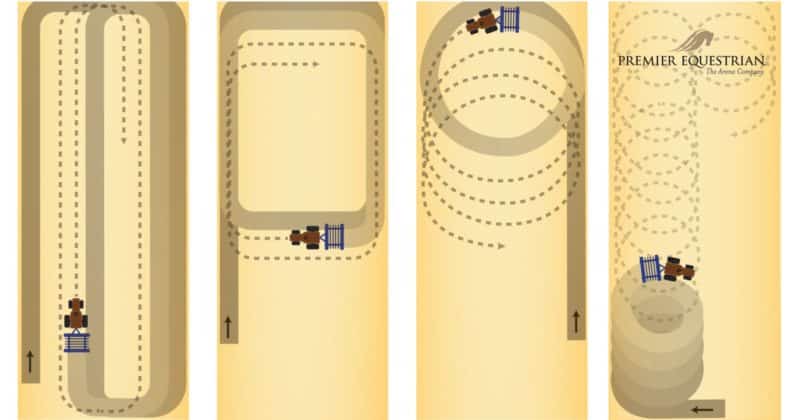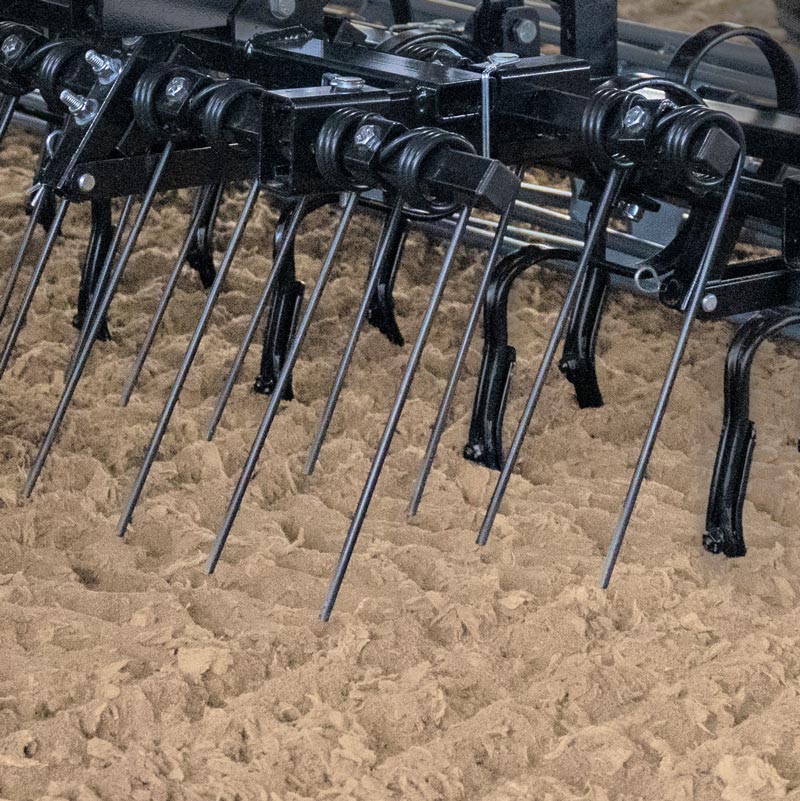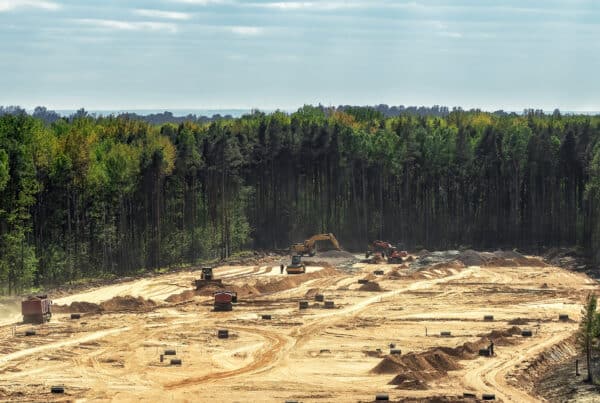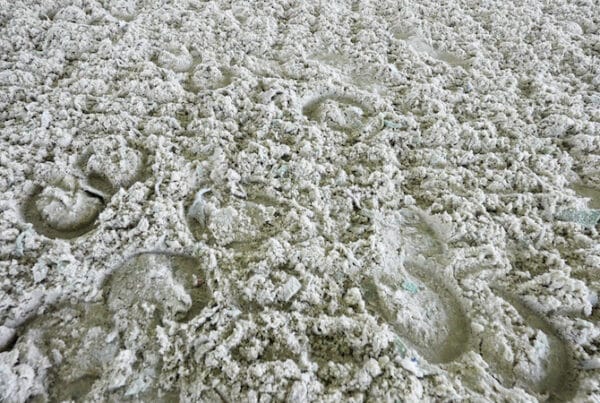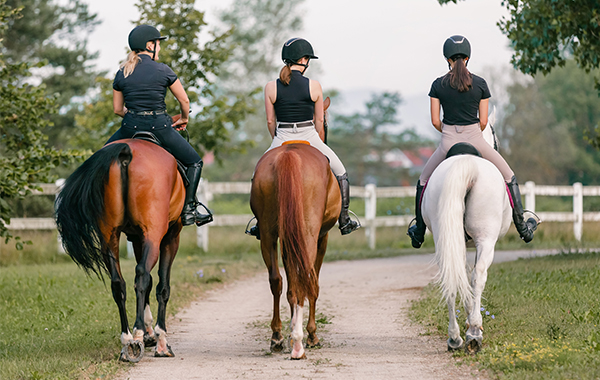Despite all the care and attention that we riders put into our horses’ well-being, a surprising number of equestrians may be overlooking one important duty from our list: regular arena maintenance. Sure, we all love to ride in a freshly groomed ring, when our horse’s feet will be the first of the day to track a perfectly round circle or a daringly accurate turnback between fences. But how many of us also love to jump on the tractor and groom the arena surface, or hand rake the corners and edges? Let’s face it…riding is usually more fun.
Many years ago, I spent a frustrating summer trying to maintain an older dressage horse’s 4th Level skills and fitness while riding in a lumpy, overgrown grass field. Periodically, I shipped him to my trainer’s farm for a lesson; back in her carefully groomed and prepared ring, he went like a completely different horse. I attributed the difference to having her help on the ground (and I am sure that was important, too) but one day she just looked at me and said, “A horse can’t be expected to work any better than his office allows him to.”
Her point, of course, was that the more we ask of our horses, the more we must ask of our footing to support them—and that means that we must do our homework when it comes to proper, routine arena maintenance. Regular grooming will eliminate inconsistencies in the footing and keeps the particles evenly mixed. Hard packed or high-traffic areas (such as along the rail) will be loosened, while deeper areas resulting from larger particles getting pushed to the top will be smoothed and reintegrated. In fact, performing routine arena maintenance—which includes grooming and moisture maintenance—will probably be the single most important factor in promoting the long-term performance of your footing.
But grooming your arena doesn’t need to be an unpleasant chore; in reality, creating a regular arena maintenance schedule will likely make each task easier to manage and will reduce the likelihood you will need to do major work in the future. Obviously, specific riding arena needs will vary depending on season, climate, and the volume of horses using the ring. However, following these general guidelines should help keep almost any arena ‘on the level’. (Note: We use the term “grooming” and “dragging” interchangeably.)
DAILY ARENA GROOMING DUTIES
Most arenas being used on a moderate or heavy basis will require daily care. If only a handful of horses work in the ring daily, these chores may be completed every other day.
Goal: Erase hoof prints, tidy up the track and around jumps, re-level surface
Task: Perform basic grooming of arena (see our suggested arena drag patterns and mix it up so your tractor doesn’t compact certain areas more than others—I also recommend a set of headphones and some good tunes to keep you rolling along). Remove all organics (usually manure/urine/leaves) to prevent them from breaking down and creating dust. Attend to moisture, if needed (click here for more info on moisture management, riding arena dust control, and arena hydration solutions).
WEEKLY ARENA GROOMING DUTIES
Vibrations and movement will cause arena particles to separate by size, leaving smaller particles on the bottom and the largest ones on top. If we don’t get the various sizes more evenly mixed, the top layer will become unstable and the bottom layer will compact. If your arena sees heavy use, if the weather has been exceptionally soggy, and/or your arena has been sitting unused or ungroomed for more than a few days—you will need to do what we call a “deep conditioning” treatment.
Goal: Here, we are looking to get beyond the surface and dig deeper through the footing, mixing particles more thoroughly than a basic daily horse arena drag.
Task: Remove jumps and dressage corners from the arena. Pay extra attention to the take-off/landing zones where fences were positioned as well as along the inside ring of the dressage court. Hand rake corners, edges, and other “hard to reach” areas.
ABI SportPro Arena Drags – Premier Equestrian Edition have S-tines (which dig, lift, mix, fluff and level the arena) and coil tines (which create a vibrating action to blend, smooth, finish, fill grooves and pack down the surface). For deep-conditioning, you will need to adjust the tines on your arena drag to penetrate further into the footing surface. Roller bars will prevent the tines from digging too deep.
ANNUAL ARENA GROOMING DUTIES
Even well-maintained arenas need an annual “spring cleaning” where we really take the time to thoroughly and completely remix all components of the footing. This is called “flipping” the arena, and it’s an important step for arenas that have settled over a long period as well as those which have received limited or no regular maintenance. Additionally, this is a good opportunity to assess if additional sand or arena footing additives are needed, or even to inspect the base or base mats if they are installed on your surface.
Goal: To thoroughly re-blend all components of the footing down to the base and to check quality of sand, additives, and base/base mat integrity.
Task: Scrape the footing down to the level of the base and thoroughly blend materials. Add additional materials as needed.
Regular arena grooming and maintenance tasks should be considered as important to your horse’s long-term well-being as good shoeing, nutrition, and regular grooming and exercise. Attending to these duties on a consistent schedule will ensure not just footing longevity but that your horse has the best office space in which to do his job.
QUESTIONS ABOUT ARENA DRAGS & GROOMERS? CONTACT US!
ALL CONTENT COPYRIGHT 2021 PREMIER EQUESTRIAN
About the author
Christina Keim is a professional equestrian and writer based at Cold Moon Farm in Rochester, NH. Over the course of her career, she has worked as a barn manager, head groom, riding instructor, and collegiate equestrian team coach. In 2015, she founded Cold Moon Farm with the mission to promote sustainable living, conservation, and the highest standards of compassionate horsemanship.

